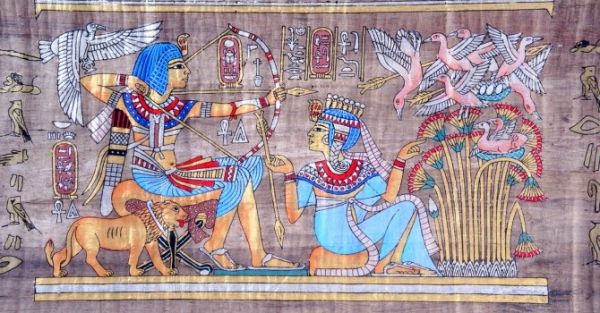Women in Ancient Egyptian Civilization
The ancient civilization of Egypt, with its awe-inspiring pyramids, enigmatic hieroglyphs, and complex societal structures, has captivated the world's imagination for centuries. Among the many aspects that make ancient Egypt remarkable is the pivotal role that women played in this society. Women in ancient Egypt were not confined to the background; they were active participants in various facets of life, ranging from family and religion to art and mythology. This essay delves into the multifaceted role of women in ancient Egypt, exploring their societal roles, rights, representation in art, and presence in mythology.
Role of Women in Ancient Egypt
The women of ancient Egypt enjoyed a level of autonomy and influence that set them apart from many other contemporary civilizations. While the society was structured hierarchically, with the pharaoh at the pinnacle, women held positions of authority and respect throughout various strata of society.
- Family and Household: In ancient Egyptian society, the family was the cornerstone of social life. Women held significant authority within the family unit, serving as mothers, wives, and daughters. Mothers, in particular, were revered for their nurturing roles and often depicted as protectors of their children. They were responsible for instilling moral values and cultural practices into the younger generation.
- Economic Activities: Women in ancient Egypt were actively involved in economic activities. They participated in trade, managed farms, and engaged in craftwork such as weaving and pottery. Wealthy women even had the opportunity to own and manage property, further enhancing their economic status and influence.
- Religion and Priesthood: Religion played a crucial role in ancient Egyptian society, and women were deeply involved in religious practices. Some women held roles as priestesses, performing rituals, maintaining temples, and serving specific deities. The high priestess of the goddess Hathor, for example, was a revered and powerful position.
- Government and Politics: While ancient Egypt did not witness many women as rulers, there were instances of women exerting political influence. Queen Hatshepsut is perhaps the most famous example. She ruled as a pharaoh in her own right, effectively governing the kingdom during a prosperous period.
Women's Rights in Ancient Egypt
In contrast to several contemporary societies, ancient Egypt afforded women a range of rights and privileges. While these rights were not equivalent to those enjoyed by men, they were significant considering the era's societal norms.
- Property Ownership and Inheritance: Women could inherit and own property, and widows often inherited their deceased husbands' estates. This legal framework ensured economic stability and autonomy for women.
- Divorce and Marriage: Women had the right to initiate divorce and had some control over their marriages. They were not forced into unions against their will, and marital contracts could include clauses to protect women's rights.
- Legal Rights: Women could appear in court, present their cases, and testify as witnesses. This level of legal participation demonstrates that their voices were acknowledged and valued.
Women in Egyptian Art
Art in ancient Egypt serves as a visual record of the roles and significance of women in society. Women were depicted in various roles and contexts, shedding light on their diverse contributions.
- Family Representations: Art frequently portrayed women within familial contexts. Scenes of mothers breastfeeding, families interacting, and women participating in religious rituals showcased their essential roles within the family unit.
- Royalty and Authority: Royal women were depicted in regal attire, highlighting their status and authority. These depictions showcased the respect accorded to queens and princesses and reinforced their roles in maintaining the kingdom's stability.
- Work and Daily Life: Artwork also captured women engaged in economic activities such as farming, weaving, and pottery making. These depictions illustrate their active contributions to society's economic fabric.
Women in Egyptian Mythology
Egyptian mythology was rich with powerful goddesses and tales that reflected the societal reverence for women.
- Goddesses: The ancient Egyptian pantheon included numerous goddesses who represented aspects of life, death, fertility, and wisdom. Isis, Hathor, and Maat were among the revered goddesses symbolizing motherhood, love, and justice.
- Myths and Legends: Myths often centered around goddesses and powerful women. The story of Isis and Osiris, for instance, showcased Isis's determination to resurrect her husband Osiris and her role as a mother figure.
- Symbolism: Some goddesses embodied contrasting qualities, revealing the multidimensional nature of women. Sekhmet, for example, symbolized both healing and destruction, highlighting the complexity of women's roles in ancient Egyptian mythology.
The study of women in ancient Egypt unveils a society that differed markedly from many of its contemporaries. Women held influential roles in family, religion, economics, and even politics. Their rights and autonomy, while not on par with those of men, were substantial for their time. Art and mythology further emphasize the depth of their contributions, as they were celebrated as both nurturers and authoritative figures. By acknowledging the significant roles women played in various facets of ancient Egyptian life, we gain a more complete understanding of this fascinating civilization's complexity and depth.
Best Egypt Private Tours 2025
| Tour | Itinerary | Price |
|---|---|---|
| Luxor and Aswan Travels | 4 Days | $ 665 |
| Cairo Holiday Packages | 5 Days | $ 819 |
| Cairo to Petra Tour | 7 Days | $ 975 |
| Cairo and Luxor Holidays | 5 Days | $ 975 |
| Egypt and Dubai Tours | 8 Days | $ 1020 |
| Turkey and Egypt Tours | 8 Days | $ 1060 |
| Egypt Overland Tours | 8 Days | $ 1105 |
| Wheelchair Accessible Nile Cruise | 4-5 Days | $ 1145 |
| Cairo and Istanbul Tours | 12 Days | $ 1510 |
| Pyramids and Nile Cruise Holidays | 8 Days | $ 1510 |
